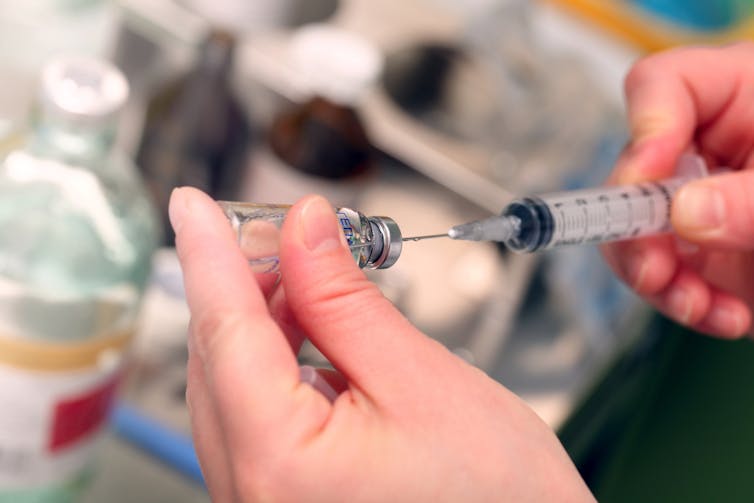We don't need to change how we subsidise 'breakthrough' cancer treatments
- Written by Richard De Abreu Lourenco, Senior Research Fellow, University of Technology Sydney
 Applications to list drugs on the PBS are usually submitted by the manufacturers of those drugs.from shutterstock.com
Applications to list drugs on the PBS are usually submitted by the manufacturers of those drugs.from shutterstock.comNew therapies that arm the immune system to fight cancer, such as Keytruda (pembrolizumab) and Yervoy (ipilimumab), have offered patients with advanced melanoma real hope of effective treatment.
But until these drugs, known as immunotherapies, were publicly subsidised, they were prohibitively expensive for Australian patients. A patient using Keytruda, for example, would be out of pocket an estimated A$150,000 per year of treatment.
Read more: How does Keytruda treat melanoma and why is it so costly?
The Pharmaceutical Benefits Advisory Committee (PBAC) recommends which drugs to subsidise and list on the Pharmaceutical Benefits Scheme (PBS). The PBAC uses the same process for all drugs, regardless of the health condition the drug will treat.
Some argue considerations of cost-effectiveness that have been used for years are not a good fit for new cancer therapies, particularly immunotherapies. The argument is that these considerations overlook some unique benefits new drugs offer that aren’t relevant to old medications, and that we should review how we consider such drugs for funding.
But looking at the processes that led to Keytruda and Yervoy being listed on the PBS, we argue the way PBAC currently works serves us well.
How the PBAC makes decisions
The health minister can’t list a drug on the PBS without a PBAC recommendation to do so. For the PBAC to consider a drug, it has to receive an application. Generally, the manufacturer of the drug submits the application.
The process has a fixed 17-week period from submission of the application to the PBAC meeting. During this time, applicants can provide evidence for the committee to consider. A list of all submissions being considered by the PBAC is published prior to the meeting so members of the community can provide their views.
More recently, the PBAC has invited patient groups to attend hearings and provide evidence.
 A drug needs to be recommended by the Pharmaceutical Benefits Advisory Committee to be listed on the PBS.from shutterstock.com
A drug needs to be recommended by the Pharmaceutical Benefits Advisory Committee to be listed on the PBS.from shutterstock.comSince 1993, legislation has required the PBAC to consider the health outcomes and costs of a new medicine relative to currently available treatments. Typically, the PBAC assesses the effectiveness of a drug according to its impact on the length and quality of life of the patient taking it. This is expressed in a measure called the quality adjusted life year (QALY).
The committee then judges whether each cost per QALY represents value for money for society, and whether it has confidence in those values given the data available. The PBAC also considers other factors, including equity of access and the availability of alternatives.
Read more: New cancer drugs are very expensive – here’s how we work out value for our money
But there have recently been suggestions that some of the benefits of immunotherapies are overlooked when the focus is on the cost per QALY. These include increased durability of the response for some patients, reduced treatment costs for the future, improved productivity and the value of hope to patients.
But if these benefits were indeed being overlooked, we might expect immunotherapies not to be listed on the PBS, or delays in listing. This has not been the case.
Immunotherapy case studies
The PBS recently added two immunotherapy drugs for patients with metastatic melanoma (melanoma that has spread): Yervoy (ipilimumab) and Keytruda (pembrolizumab).
Yervoy
PBAC first considered an application from Yervoy’s manufacturer in July 2011. Despite the drug being seen as a breakthrough in the treatment of metastatic melanoma, the PBAC didn’t recommended it for listing then. It only did so in November 2012 after two subsequent applications from the manufacturer. Yervoy was added to the PBS in August 2013.
The reason for this delay was that the PBAC was initially uncertain of the drug’s efficacy and cost-effectiveness, based on the evidence it was given. This was in part because the primary evidence was a study that compared Yervoy with a vaccine not used in Australian practice.
In the study, 50% of patients treated with Yervoy lived 3.7 months longer than those who received just the vaccine. But these results couldn’t be directly translated to Australian practice, where treatment at that time was different.
 Cancer immunotherapy drugs work by arming the immune system to fight the cancer.from shutterstock.com
Cancer immunotherapy drugs work by arming the immune system to fight the cancer.from shutterstock.comPBAC accepted evidence for the prolonged response and survival for people on Yervoy, as a result of the two resubmissions. But the magnitude of those gains was uncertain as they reflected the experience of around 10% of the study’s patients. The ongoing costs were also uncertain – there was no answer as to how long patients would need to remain on Yervoy, or whether they would need treatment again.
But, overall, the PBAC recognised the potential benefits of the drug. It was made available through the government and the manufacturer entering into a risk-sharing arrangement. Under this agreement, the government would review what it paid for Yervoy to take account of the outcomes being achieved in patients, as well as how much the drug was being used.
Keytruda
Keytruda had a faster, but no less complex, passage to PBS listing. PBAC considered the application in March 2015 to list the drug for metastatic melanoma. This was after a series of stakeholder meetings, including representatives from government, patients, clinicians and the manufacturers, as well as a rolling submission of evidence during the 17-week PBAC evaluation process.
Initially, no evidence was available of a direct comparison between Keytuda and the relevant comparator, which was the previously listed Yervoy. But a randomised controlled trial became available as evidence during the evaluation.
These data showed Keytruda was likely to be at least as beneficial as Yervoy, with the potential for better long-term survival. This, together with a risk-sharing arrangement similar to the one applied to Yervoy, was sufficient for the PBAC to recommend PBS listing from the first submission.
Keytruda became available as a PBS-listed item for melanoma in September 2015. This provided access to an additional care option for around 1,100 patients.
In both cases, the process was sufficiently flexible in response to the available data to make a positive recommendation for listing. It is unclear how changing requirements for evidence for these or other cancer drugs, or introducing different reimbursement models, would have better served these drugs or the patients who use them.
Richard De Abreu Lourenco receives funding from NHMRC, Cancer Australia, the Victorian Cancer Agency and the Department of Health. None of the views expressed in the piece relfect the views of those agencies.
Marion Haas receives funding from the NHMRC and Cancer Australia. She is a member of the CanTeen Strategic Advisory Committee. None of the opinions expressed in this article reflect the views of these organisations.
Rosalie Viney was previously a member of the Pharmaceutical Benefits Advisory Committee. She receives funding from Cancer Australia and the NHMRC.
Authors: Richard De Abreu Lourenco, Senior Research Fellow, University of Technology Sydney






